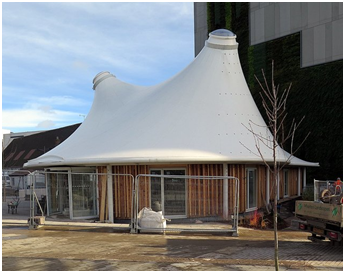When considering a new structure, especially when adding to an existing building, more and more people and companies are realising the potential of fabric structures. With advances in materials and techniques, this kind of architecture is becoming more common and more popular as the advantages it offers become clear.
Of course, a tensile fabric structure isn’t going to be suitable for every situation; different problems require different solutions. There will be times that a conventional structure is the better option. It’s worth being aware of the advantages and disadvantages of fabric structures as opposed to more traditional brick, concrete or even wood. Some benefits are made clear here: http://fabricarchitecturemag.com/2016/06/01/shade-systems-to-the-rescue/.
Light and Airy
One obvious advantage of fabric canopy structures is that they are translucent. They allow in a reasonable amount of light, but unlike glass or polycarbonate, they keep the glare out. This allows for a pleasantly airy atmosphere in nearly all weather conditions.
Another advantage of fabric architecture is that it is lightweight. The supporting structure is minimal, as tensile fabric can be stretched across an area which would require considerable support if heavier materials were used. This allows for more space inside the structure and for less material to be used in the construction, although the downside of this can be that heavier foundations are needed where wind might lift the canopy. Foundations are, however, still cheaper and simpler to prepare than above ground constructions.
Minimum of Fuss
Another advantage of fabric architecture is that most of the manufacturing takes place away from the site, so there is far less disruption – something to consider when a building is in constant use!
A disadvantage of fabric architecture which needs to be mentioned is that it is not always cost effective for very small constructions, as the same planning and engineering issues would be present. Fabric structures become more cost effective the bigger they are, and accordingly they offer economies of scale to a much greater extent than other construction materials.
Fabric structures are almost impervious to weathering and environmental damage, although of course they are not immune to vandalism or having heavy weights dropped on them!
Tensile fabric structures can be striking pieces of design which are both cost effective and efficient. They may not be right for your project, but they may well be worth investigating!

